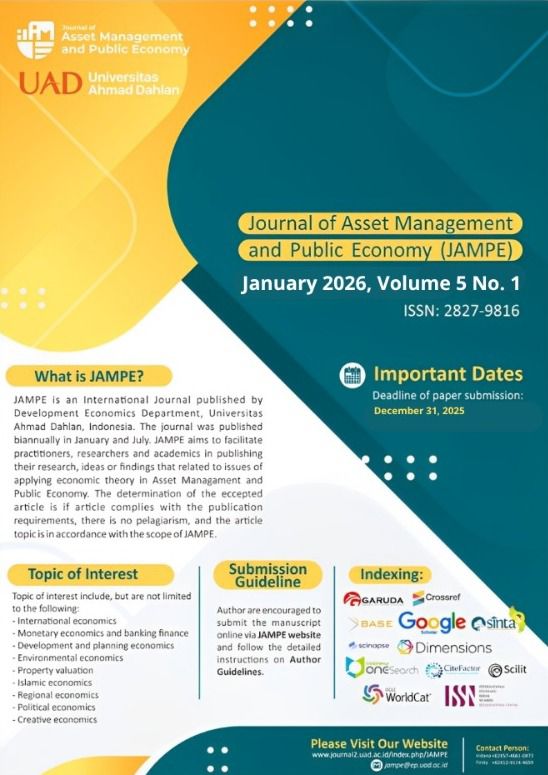
About the Journal
| Journal title | Journal of Asset Management and Public Economy |
| Initial | JAMPE |
| Abbreviation | J Asset Manag Public Econ. |
| Frequency | 2 issues per year (January and July) |
| DOI | Prefix 10.12928 |
| Online ISSN | 2827-9816 |
| Editor in Chief | Indanazulfa Qurrota A’yun |
| Managing Editor | Firsty Ramadhona Amalia Lubis |
| Publisher | Universitas Ahmad Dahlan |
| Citation Analysis | Google Scholar | Garuda |
Journal of Asset Management and Public Economy, JAMPE, is managed and published by the Department of Development Economics, Faculty of Economics and Business Ahmad Dahlan University. The journal was published biannually in January and July. JAMPE aims to facilitate practitioners, researchers and academics in publishing their research, ideas or findings that related to issues of applying economic theory in Indonesia or other countries in the world. Articles must be scientific, original and unpublished. JAMPE does not publish manuscripts in critical review and book review. Articles published in this journal through the blind review process and reviewed by a minimum of two reviewers. The determination of the accepted article is if the article complies with the publication requirements, there is no plagiarism, and the article topic is in accordance with the scope of JAMPE.
https://epresensi.mempawahkab.go.id/app/
https://www.tropicalrb.com/en/
https://www.portsydneycofc.com/
https://artha.vc/media-events/
https://www.kartplaza.nl/contact/
https://humansoffuzia.com/about-us/
https://thepetershamcoventgarden.com/menu/
https://swisselitetransfers.com/
Bonus Buy Satu Tembakan, Tumbler Panjang Menggelinding: Bonanza Xmas Bagi Kejutan
https://disegnidacolorarewk.com/politica-sulla-riservatezza/
https://www.jeanpauljeunet.com/reservation/
https://heylink.me/wangi4d.link/
https://www.seputarpengetahuan.com
https://www.cosyoffices.com/contact/
https://www.seputarpengetahuan.com/
https://www.cosyoffices.com/privacy/
https://cheerdocious.com/store/
https://gajarephotography.com/gajare-gallery/
https://thepetershamcoventgarden.com/menu/
https://siec.gov.sb/contact-us/
https://litystory.com/contact/
https://www.shourachemicals.com/en/our-company
https://www.black-vanilla.com/about-us.html
https://twincitygardenclub.com/conservation/
https://hatidhafsins.is/english/
https://colloquia.treccani.it/
https://ecamaragon.com/cancelacion-de-reservas/
https://streamingvenezuela.com/
https://www.kingstonroofers.com/installations-fixes-for-eaves-and-rain-gutters/
MANDIRIBET LOGIN DAFTAR ALTERNATIF
https://penanghillco.com.my/lunch-set-menu/
https://foodrecipes.club/about
https://brickrestaurantgroup.com/home.php
https://unaricareceta.com/tortitas-integrales/
https://golan-marsad.org/links/
https://daftar.bpsdmd.jatengprov.go.id/user/
https://jurnal.unmabanten.ac.id/
https://wanpasifik.org/lagatoi-declaration/
https://www.bsind.org/departments/
https://www.bsind.org/departments
https://imuslimpac.altmansolutions.com/
https://thelittledepotdiner.com/menu/
Jangan lupa main di linksitus gacor terbaru hari ini
https://tenissauconymexico.com.mx/
Harta138 : Daftar Situs Slot Gacor Hari Ini Bonus Maxwin
https://www.harambeans.com/contact/
https://rockcomciencia.crp.ufv.br/
https://hotelcasanicole.com/restaurant/
https://septimocongreso.redue-alcue.org/
https://internship.infoskaters.com/
https://hci-vr.dit.uop.gr/tripmentor/
https://aulavirtual.ucel.edu.ar/
https://perpustakaan.mahkamahagung.go.id/
https://idep-applications.uneca.org/
https://sippdb-tanjungpinang.com/
https://rans303slot.kismisjeruk.com/
Edukasi Kuliah, Informasi seputar dunia perkuliahan
Institut Agama Islam Muhammadiyah Sinjai
Announcements
https://yayinevi.atauni.edu.tr/
https://moodle.peq.coppe.ufrj.br
https://www.cambridgehub.org/contact
https://fsrenevis.com/caribbean-citizenship/
https://www.onefinancialsolutions.co.uk/about-us/
https://nagahama-ryokan.com/sakura/
https://www.thevillagebrewhouse.com/michael/
https://shortterm12.com/ilir-meta-biography/










